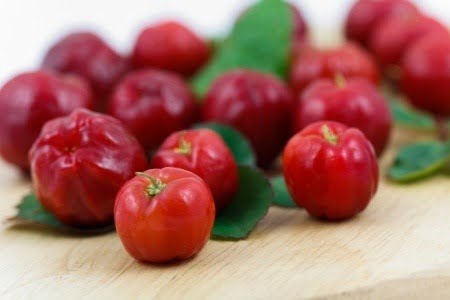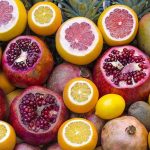
♦ Acerola Juice: How Good Is It ? Well great for vitamin C.
A blogger asked me what acerola was, having spotted it on some ingredient lists for beverages – was it a juice or another colour or even a vitamin ? Having worked with it as one of the most concentrated sources of naturally derived vitamin C in beverage development, I was keen to see if others were interested in it. To some product developers, the pulp is a valuable alternative to adding vitamin C directly as in bread production.
Acerola (Malpighia emarginata DC.) is Spanish for maple cherry but also known as the West Indian Cherry and is a small tree or shrub. It should not be confused with its lesser cousin Malpighia glabra L. It grows in dry climates and produces bright red fruit from 1 to 2 cm in diameter. It was originally from the Antilles, but was introduced into Brazil about 50 years ago. It is widespread throughout Central America and the Caribbean too. Brazil is the major worldwide grower with over 35 thousand Tonnes of fruit produced annually (Nogueira et al., 2002), a major consumer and exporter of both fruit and its juice. The fruit is highly perishable so it is usually processed to a pulp or clarified juice (Matta et al., 2004). The juice is pleasant but quite tart which means it is best combined in other juice formulations.
Nutritional Value Of Acerola
It is a functional food because of its extremely high vitamin C content. Values are quoted for up to 957–1074 mg/100 g (Vendramini and Trugo, 2000; De Assis et al., 2001; Freire et al., 2013) for pulped fruit. There is about 50 to 100 times more vitamin C in acerola juice than an equivalent volume of orange juice. It also contains carotenoids, ranging from 371–1881 μg/100 g (De Rosso and Mercadante, 2005 , and a high colour content from its anthocyanins with levels of upto 77 mg/100g reported (Santini and Huyke, 1993; Hanamura et al., 2005; Mamede et al., 2009). The anthocyanins were identified as pelarginidin, malvidin 3,5-diglycoside and cyanidin-3-glycoside. It has a very high antioxidant potential which is a useful marketing strapline.
The volatiles consist of 150 compounds recorded (Boulanger and Crouzet, 2001; Pinot and Marbot, 2001). The major components are furfural, hexadecanoic acid, 3-methyl-3-butenol and limonene. The esters are thought to be the main contributors to acerola’s unique flavour.
The fruit pulp has potential in syrups and jams with the vitamin C providing some functional help in reducing browning if added at the appropriate levels.
I’m surprised to read though how natural vitamin C is claimed to be better for you than the same vitamin prepared synthetically – they are in reality one and the same ingredient and should be no different in terms of nutritional benefit ! Still, there are web-sites out there with beverages and syrups making this distinction. The Brazilians use the fruit in natural remedies, especially to alleviate fevers and dysentery, but it also has other useful attributes associated with controlling inflammation. Other claims are made for benefits in ‘energy’ and improving the immune system. If further research can be committed to understanding if its other nutritional benefits are true, other than its high vitamin C content, it would prove an extremely valuable fruit. Some early studies in a mouse model indicate that feeding acerola juice helps to reduce oxidative stress and ameliorate genotoxicity under certain conditions (Leffa et al., 2013).
Acerola Pomace
Acerola pomace is a source of rutin using aqueous two-phase extraction (Reis et al., 2013). There is a also strong commercial need to reduce post-harvest losses as this fruit is particularly prone to bruising and with it vitamin C loss (Delva and Schneider, 2013). The author is keen to work with others in developing a story for new South American fruits including Camu-Camu having recently conducted a survey for a client on new fruit sources for functional uses.
Nexira supply spray dried powder extracts containing 17% and 25% w/w vitamin C.
References
Boulanger,R., Crouzet, J. (2001) Identification of the aroma components of acerola (Malphigia glabra L.): free and bound flavour compounds. Food Chem., 74(2) pp. 209-216
De Assis, S.A., Lima, D.C., & de Faria-Oliveira, O.M.M. (2001) Activity of pectinmethyl-esterase, pectin content and vitamin C in acerola fruit at various stages of development. Food Chemistry 74 pp. 133–137.
De Rosso, V.V., & A.Z. Mercadante, A.Z. (2005) Carotenoid composition of two Brazilian genotypes of acerola (Malpighia punicifolia L.) from two harvests. Food Research International 38 pp. 1073–1077.
Hanamura, T., Hagiwara, T. and Kawagishi, H. (2005) Structural and functional characterization of polyphenols isolated from acerola (Malpighia emarginata DC.) fruit. Bioscience Biotechnology and Biochemistry 69 pp. 280–286.
Leffa, D.L., da Silva, J., Daumann, F., et al., (2013) Corrective effects of acerola (Malpighia emarginata DC.) juice intake on biochemical and genotoxical parameters in mice fed on a high-fat diet. Mut. Res.,/Fund. Mol. Mech. Mutagenesis. Available online 1 December 2013 In Press.
Mamede, M.E.O.,Miranda, M.P.S., Ritzinger, R., Godoy, R.C.B., Velozo, E.S. (2009) Physico-chemical and sensorial evaluation of new varieties of acerola. British Food J., Vol. 111 Iss: 4, pp.387 – 395
Matta, V.M., Moretti, R.H., & Cabral, L.M.C. (2004) Microfiltration and reverse osmosis for clarification and concentration of acerola juice. J. Food Eng. 3 pp. 477-482
Nogueira, R.J.M.C., Moraes, J.A.P.V., Burity, H.A. & Silva Junior, J.F. (2002). Efeito do está dio de maturac¸ão dos frutos nas características físico-químicas de acerola. Pesquisa Agropecuária Brasileira, 37, pp. 463–470.
Pino, J.A., Marbot, R. (2001) Volatile flavor constituents of acerola (Malpighia emarginata DC.) fruit. J. Agric. Food Chem., 49(12) pp. 5880-2
Reis, I.A.O., Santos, S.B., Pereira, F.D.S., Sobral, C.R.S. et al., (2013) Extraction and Recovery of Rutin From Acerola Waste Using Alcohol-Salt-based Aqueous Two-Phase Systems. Sep. Sci. Technol. Publ. Online 13th Nov. 2013
Santini, R., Huyke, A.J., (1993) Identification of the anthocyanin present in the acerola which produces color changes in the juice on pasteurization and canning. In: Mazza, G., Miniati, E. (Eds.), Anthocyanins in Fruits, Vegetables and Grains. CRC Press Inc., Boca Raton, p. 131. Reprinted from: Journal of Agriculture of University of Puerto Rico, 40, pp. 171–176 (1956).
Vendramini, A.L., and Trugo, L.C. (2004) Phenolic compounds in acerola fruit (Malpighia punicifolia L.). J. Brazilian Chemical Society 15 pp. 664–668.



This small tree makes an excellent addition to the orchard and we grow it in California as a companion to our citrus fruit. I find acerola too dry – there just isn’t enough juice to make it good for lots of juice other wise we would add it to our orange juice. I can see the benefits. We have known about this for many years but the flavour is a bit weak. It could do with having a better profile. I think it works better as a dried fruit and at least there is vitamin C left.
Nexeira have been supplying a Acerola cherry extracts for many years. The quality is superb and they are accurate with their claims.